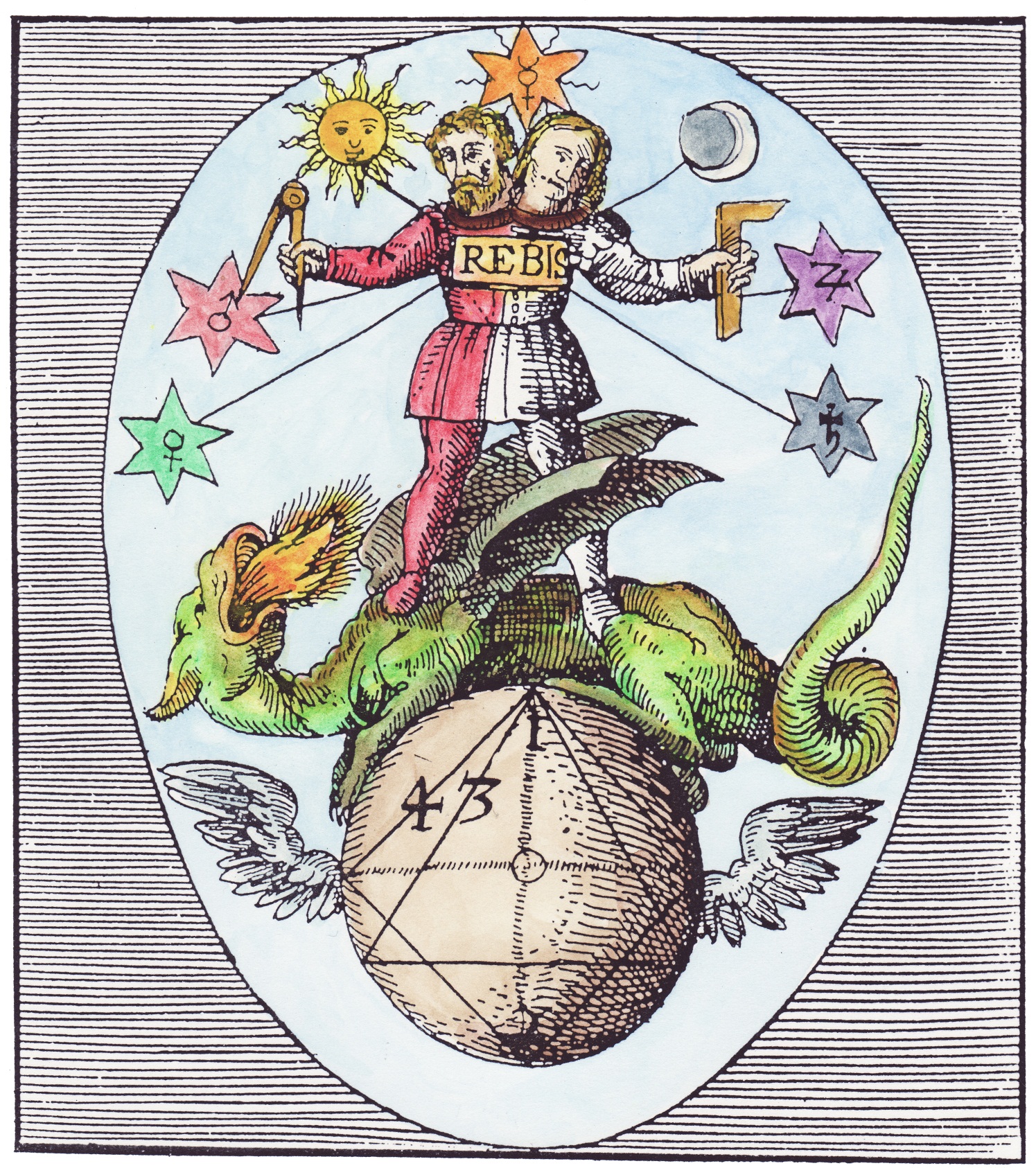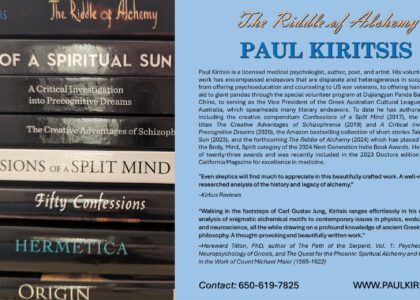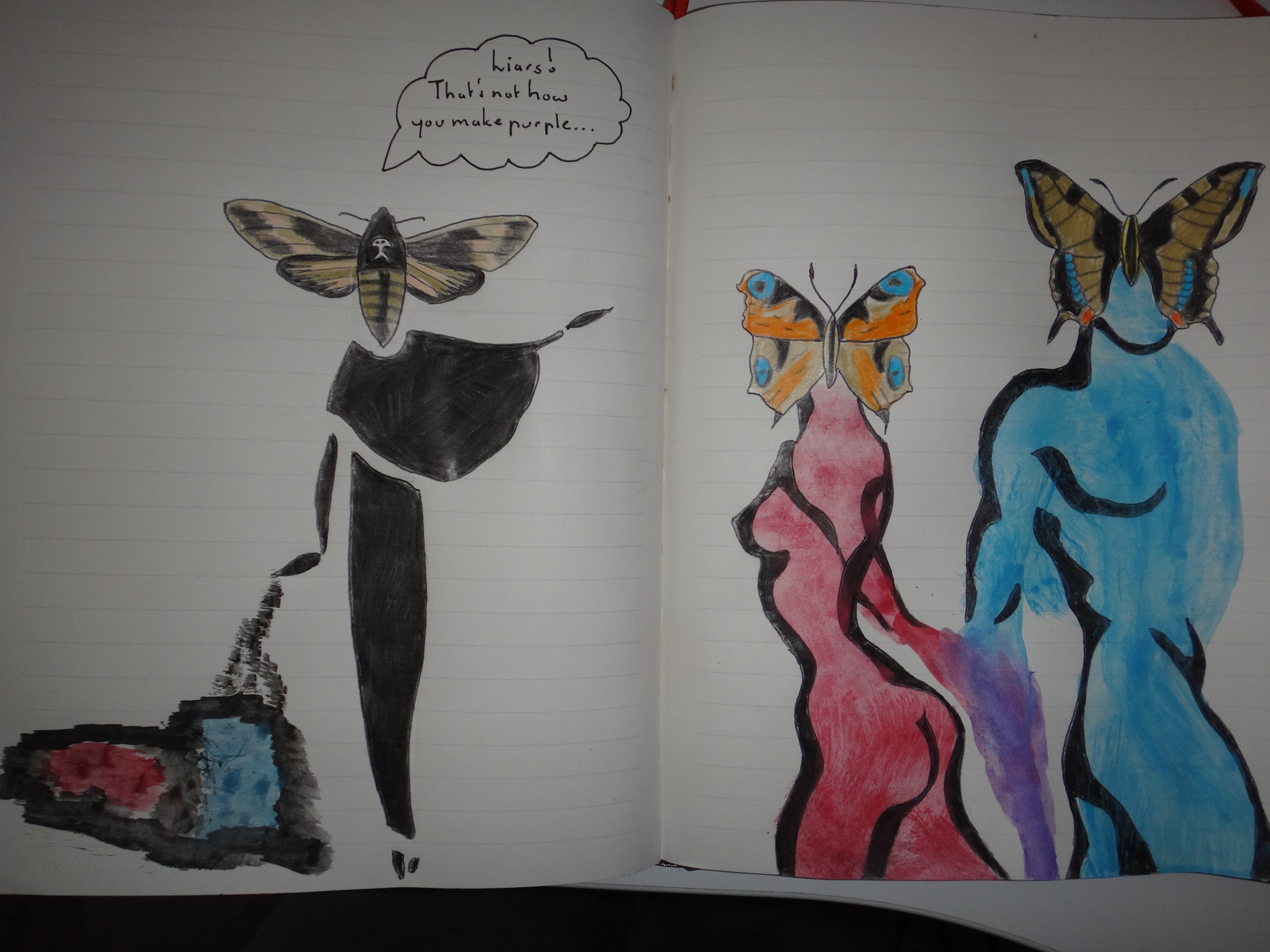
To understand the motivation behind alchemy we must travel back to the second century ce, a time when pseudepigraphic writings aimed at nurturing a philosophical and theosophical coherence of the world were ripe. The majority of these syncretised Gnostic, Stoic, Platonic and Aristotelian elements and were attributed to such historically unverifiable figures as the thrice-greatest Hermes Trismegistus and Moses; deities like Isis, Horus and Agathodaimon; and legendary figures like Ostanes, Pammenes and Cleopatra. The most pivotal to our study is the opening text of the Corpus Hermeticum, a tractate entitled “Poimandres”. In it the anonymous author lays bare the conviction that the essence of microcosm and macrocosm, of the human being and the cosmos as a whole, are made comprehensible only through revelation or mystical insight. This Gnostic system of thought attributes the creation of the universe to the interaction of two principles; pure spirit, otherwise known as God, and matter. The former is fiery and active, the latter reflective and passive. According to the frame narrative the process of becoming was mediated by two sentient beings that differentiated from the virginal spiritual-noetic substance. First was the demiurgic spirit or “nous” which proceeded to order the fixed sphere of the stars, the seven planetary spheres with their respective daemons, and the sublunary realm. This was followed by a disembodied protohuman who recapitulated the entire order on a much smaller scale.
Evident thus far should be a welcomed departure from conventional renditions of creation such as the ones we might read in Biblical Genesis or the Sumerian account of Ulligara and Zalgarra. The disembodied protohuman, the ethereal model of man in other words, wasn’t subordinate to God; he was one with God, God’s sibling or brother. Unencumbered by the density of incarnation, ethereal man was loved by God “as his own child” and bestowed all the honours and privileges that went with such a favourable sentiment. He was omnipotent, transcendent and immortal, with demiurgic powers of cogitation that made him the envy of the celestial and earthly beasts. In the end it was his own curiosity that rendered him impotent. Wishing to examine the created essence of matter more closely, he descended along the multidimensional rungs of the cosmic scale until he reached the last realm, the sublunary. Here, he peered upon the supernal face of Mother Nature and became enamoured of her. She reciprocated these feelings and, acting upon her own lower and involuntary impulses, pulled him across to her side. The consequential act transformed him into an entirely composite being; his newfound corporeality imposed a condition of mortality yet his soul-spark derived from the Empyrean, the ethereal fire of heaven, and remained immortal. He was also hermaphroditic in nature, consisting of both male and female parts.
A second century non-Christian text from the Naq Hammidi Library entitled “The Apocalypse of Adam” expounds this aspect through an expository narrative between Adam, the first human being, and his son Seth. In the story Adam equates the condition of paradisal perfection and knowledge of original gnosis with a hermaphroditic constitution, revealing that the “fall” only occurred after the enraged god Yaldabaoth, the “ruler of the aeons of the powers,” divided the corporeal androgynous protohuman into male and female. Alchemy appropriates this Gnostic viewpoint and ascribes salvation to the reintegration of the feminine and masculine powers within oneself. The purpose then of anyone who awakens to this higher call is to reascend the seven planetary spheres, fragmenting as it were the anatomy of his or her soul and giving back parts to the respective daemons, to reconcile the integral “Adamic” state of uroboric wholeness and finally to commune with and become one with the Godhead in the eighth, the Empyrean. A pictorial representation of this idea is immortalised in the opening plate of the Mutus Liber, where two angels trample up and down a Jacob ’s ladder and blow into their trumpets in an attempt to awaken a sleeping figure at the bottom. From this perspective the alembic or vessel is the human body and the Philosopher’s Stone is consciousness purified of its physical drives and carnal desires through a repeated cycle of conjunctions, or chemical marriages if you like, between the masculine and feminine powers–Sol and Luna.
Just as you might experience reality through the mediation of your five physical senses, so too does alchemical esotericism strive to comprehend the psychoneotic realm through elements, properties and organic processes manifest in the natural world. The idea is embodied in the Hermetic tenet, “As above, so below,” which might be taken to mean that everything existing on the material plane is a flawed variety of an ideal equivalent on the next whirl of the cosmic spiral (i.e. think Platonic metaphysics). Similarly, “As inner, so outer” expresses a fundamental correspondence between the laws of macrocosm and microcosm, or the demiurgic spirit (“nous”) and the ethereal protohuman if you prefer. An attempt to validate these laws prompted the early alchemists to seek out and identify a material constituent for the prima materia–the protean, volatile, ever-vacillating and elusive base substance of which the cosmos and the human soul has been hewn. Two that seemed to fit the mould were water and mercury. The first was soon excused on the premise that that it was way too abundant in nature to encompass the quintessence of an immutable substance which had not partaken in the irrational eruptions of creation. Furthermore, it had already been implicated as one of the first four qualities or principles to differentiate from the primordial chaos by both Empodocles (492-432bce) and Aristotle (384-322bce). This left Mercury as the sole candidate. Whilst alchemists of all ages have emphatically claimed that “their mercury is not the mercury (Hg) of the vulgar herd,” we can be more than certain that the latter’s miraculous and mutative properties is what inspired it.
Let’s take a brief look at the central and pivotal role of Mercury in the Magnum Opus. When alchemical treatises speak of Mercury or Mercurial Water they are referring to the menstruum and matrix of the cosmos, the undifferentiated first matter comprised of both the hot, dry and active masculine principle and the moist, cold and receptive feminine principle. Both are expressed exoterically under the rubric of elemental sulphur and argent vive. This paradoxical duality defines the differentiating aspect of the prima materia, but it can also be seen during painstaking procedures carried out in the alembic and in the end result, the ultima materia. Given that Mercury was the only known substance which demonstrated an inherent talent for solve et coagula (meaning to dissolve and coagulate, or separate and join together) by amalgamating other metals, it came to be seen as the rebis or hermaphrodite, as well as symbol for alchemy in its entirety.
Mercury’s numinous and animating spirit was protean; it couldn’t be seen or touched, yet it pervaded elementary processes which unravelled through a twofold struggle between philosophical sulphur and argent vive. On one hand it was the vitriol, the poison or the vinegar that killed the plant, mineral or metal in the alembic and reduced it to a putrefying mass, and on the other it was the water that washed over the dead residue or ashes and resurrected it anew. If anything, the Mercurial nature was a living contradiction, akin to an African lioness mothering a lamb or an atom being in two places at the same time. The she-man or he-woman couldn’t quite make up its mind about what it wanted to be, what its name was or for how long it wished to assume the intended role for that matter. It would show up during chemical operations as a duplicitous male trickster that released poisons and dissolved substances one minute and as a faithful female servant who contrived elixirs and coagulated substances the next. Unlike everything else on the planet Mercury had no stabilising form, weight or temperature; it reasoned through impulse and acted covertly.
The early alchemists never ascribed Mercury to a particular stage of the alchemical opus because it was the formative force behind the whole work, mediating an entire process which consisted of repeated separations and coagulations between sulphur and argent vive, Sol and Luna. The degree of purity attained was shown through each new marriage or coniunctionis of these two elements. Pictorial representations of these conjunctions reveal in chronological and ascending order the couplings of hen and cock, dog and bitch, a red man and white woman, and finally, the Red King and White Queen. This dual struggle occurred within a threefold division. In this, the earliest known model of alchemical transmutation, transformation and exaltation of the prima materia (base substance) into ultima materia (preparation of gold, or the Philosopher’s Stone) was marked by four distinct phases of colouration that served as exoteric markers of a reduction process instigated by the laws of cosmic sympathy and antipathy. Thus the ultima materia was conferred form only after having undergone putrefaction through melanosis or nigredo, bleaching through leucosis or albedo, yellowing through xanthosis or citrinitas, and finally, reddening through iosis or rubedo. Purple sometimes took the place of red in the last of these stages, hinting at the royal and spiritual scheme bubbling directly beneath a process which at first appeared to be nothing more than a descriptive transcription of the colouration and purification of metals. In alchemical literature melanosis was symbolized by a black raven, leucosis by a white dove, xanthosis by a yellow flower and iosis by a red dragon or phoenix.
Both the recurring chemical marriages between philosophical sulphur and argent vive and the threefold coloured division were underpinned by a sevenfold schema based on the planetary powers and their constituent metals. The Saturnine, Jovial and Lunar forces lunarised the base matter by initiating chemical processes such as calcination, solution and putrefaction which brought about nigredo and albedo in the sealed vessel. Many alchemical treatises mention an intermediary stage known as cauda pavonis or the Peacock’s Tail between nigredo and albedo in which the decomposing matter in the glass comes back to life by forming a kaleidoscopic skin that resembles the iridescent blues and greens of a male peacock’s tail feathers. In any case successful completion of this stage and the albedo bestowed upon the alchemist the gift of the “white stone”; the power of healing and of transmuting base matter like lead or mercury into silver. Successive operations were then carried out by Venusian, Martian and Solar forces, which solarised the just formed “white stone” through chemical reduction, sublimation, coagulation and fermentation. These subsequent reactions in the sealed vessel or glass brought about citrinitas and rubedo, culminating in the synthesis of a glittering red powder of significant weight known as the “red stone”; this was the ultima materia or Philosopher’s Stone, with the power to transmute base metals to gold and impart immortality. The creation of the “white stone” under the aegis of the first three planetary powers comprised what alchemists termed the Lesser Work and the creation of the “red stone” under the aegis of the last three the Greater Work, respectively.
There can be no doubt that much of the Magnum Opus, its stages and the colours produced were inspired by the mutational aptitude and miraculous properties of mercury or quicksilver. The Chinese, the Indians and the ancient Egyptians were all intimately acquainted with the glistening red sulphide ore of mercury, called cinnabar, as well as its experiential methods of reduction from the earliest of times. The purified mercury could be used to extract gold from auriferous rocks or gold-containing quartz by cooking the two together in a stone vessel. Once all the gold was leached out the entire amalgam would be squeezed through a leather apparatus and distilled to exorcise any residue of mercury. If mercury could liberate the eternal metal, then it made perfect sense that philosophical mercury, its idealized form, was the undisputed mother of the ultima materia, spiritual gold or the Philosopher’s Stone. What’s more is that when mercury was heated in an alembic it produced a reddish orange precipitate that resembled its primitive and unrefined state as cinnabar. In former times there was no chemical analysis able to identify or differentiate between mercuric sulphide and oxide, and their quasi-characteristics were convincing enough to seduce the early alchemists into believing the two were one and the same substance. For anyone whose experience of reality was precariously hinged upon this solely qualitative vision, it would appear that the metal recovered its original “Adamic” state after suffering acute passions and agonies, an empirical “fact” which added significant weight to the alchemo-mystical conviction that each virgin soul came from the Empyrean as an extension of God and would eventually return there. Interestingly, the extraction of mercury or quicksilver from cinnabar and its subsequent oxidization through heating was a favourite procedure of medieval alchemists whose primary concern was to perpetuate the credibility of their royal art.
Some of mercury’s other distinctive reactions motivated specific ideas and symbols. For instance heating an amalgam of salt and mercuric oxide produced mercuric chloride or corrosive sublimate, a molecular compound which appeared on the upper echelons of the alembic in the form of bleached white crystals and proceeded to grow downward. This was sublimation, the stage between citrinitas and rubedo, but it was also material “proof” of the ethereal mercurial power that evoked the violent reactions necessary to raise the vibrations and precipitate the chromatic red of rubedo. Moreover when it was heated together with sulphur it produced red sulphide ore, cinnabar. The first to launch a critical inquiry into metallic properties of natural mercury such as the just mentioned were the eighth century Arabian alchemists, particularly Jabir ibn Hayyan from whom alchemy inherited the philosophical Sulphur-Mercury theory. For that reason we can be more than certain that this dualistic conception of the cosmos was based entirely upon crude observations made in the laboratory. Not surprisingly we also see the inheritance of mercurial properties in the ultima materia, gold or the Philosopher’s Stone. Natural mercury tends to be quite dense and demands storage in either stone or iron bottles given its highly reactive and volatile state. Glass, for instance, is unsuitable because it would break and all metals save for iron would dissolve. By the same token, the Philosopher’s Stone is described as a heavy red powder (or heavy liquid) that could vanish into thin air or diffuse through its retort or phial if the hermetic fires are not regulated or if alchemical operations are carried out too far. Sounds a bit like mercury, doesn’t it?








